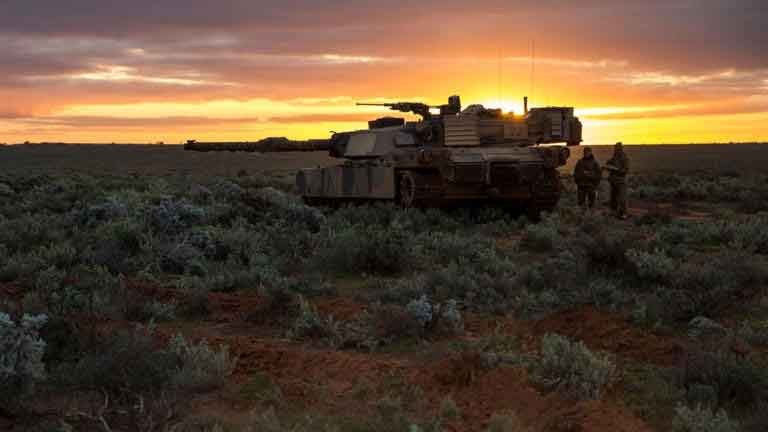Popular Science
Australia wants a laser weapon powerful enough to stop a tank
Story by Kelsey D. Atherton • 6h ago - 3-5-2023
On April 4, Australia’s Department of Defence announced the award of $12.9 million to defense giant QinetiQ for a laser weapon. The move followed years of work and interest by Australia’s government in developing lasers for the battlefields of tomorrow. What is most ambitious about the Australian research into laser weapons is not the modest funding to QinetiQ, but a powerful goal set by the Department of Defence in 2020: Australia wants a laser weapon powerful enough to stop a tank.
Laser weapons, more broadly referred to as directed energy, are a science fiction concept with a profoundly mundane reality. Instead of the flashy beams or targeted phasers of Star Wars or Star Trek, lasers work most similarly to a magnifying lens held to fry a dry leaf, concentrating photons into an invisible beam that destroys with heat and time. Unlike the child’s tool for starting fires, modern directed energy weapons derive their power from electricity, either generated on site or stored in batteries.
Most of the work of laser weapons, in development and testing, has so far focused on relatively small and fragile targets, like drones, missiles, or mortar rounds. Lasers are energy intensive. When PopSci had a chance to try using a 10-kilowatt laser against commercial drones, it still took seconds to destroy each target, a process aided by all the sensors and accouterments of a targeting pod. Because lasers are concentrated heat energy over time, cameras to track targets, and gimbals to hold and stabilize the beam against the target, all ensure that as much of the beam as possible stays focused. Once part of a drone was burned through, the whole system would crash to the ground, gravity completing the task.
Tanks, by design and definition, are the opposite of lightly armored and fragile flying machines. That makes Australia’s plan to destroy tanks by laser all the more daring.
Tanks for the idea
In the summer of 2020, Australia’s Department of Defence released a strategy called the 2020 Force Structure Plan. This document, like similar versions in other militaries, offers a holistic vision of what kinds of conflicts the country is prepared to fight in the future. Because the strategy is also focused on procurement, it offers useful insight into the weapons and vehicles the military will want to buy to meet those challenges.
The tank-killing laser comes in the section on Land Combat Support. “A future program to develop a directed energy weapon system able to be integrated onto [Australian Defence Forces] protected and armoured vehicles, and capable of defeating armoured vehicles up to and including main battle tanks. The eventual deployment of directed energy weapons may also improve land force resilience by reducing the force’s dependence on ammunition stocks and supply lines,” reads the strategy.
An armored vehicle in Australia in 2016.
© Mandaline Hatch / US Marine Corps.
Australia wants a laser weapon powerful enough to stop a tank
Story by Kelsey D. Atherton • 6h ago - 3-5-2023
On April 4, Australia’s Department of Defence announced the award of $12.9 million to defense giant QinetiQ for a laser weapon. The move followed years of work and interest by Australia’s government in developing lasers for the battlefields of tomorrow. What is most ambitious about the Australian research into laser weapons is not the modest funding to QinetiQ, but a powerful goal set by the Department of Defence in 2020: Australia wants a laser weapon powerful enough to stop a tank.
Laser weapons, more broadly referred to as directed energy, are a science fiction concept with a profoundly mundane reality. Instead of the flashy beams or targeted phasers of Star Wars or Star Trek, lasers work most similarly to a magnifying lens held to fry a dry leaf, concentrating photons into an invisible beam that destroys with heat and time. Unlike the child’s tool for starting fires, modern directed energy weapons derive their power from electricity, either generated on site or stored in batteries.
Most of the work of laser weapons, in development and testing, has so far focused on relatively small and fragile targets, like drones, missiles, or mortar rounds. Lasers are energy intensive. When PopSci had a chance to try using a 10-kilowatt laser against commercial drones, it still took seconds to destroy each target, a process aided by all the sensors and accouterments of a targeting pod. Because lasers are concentrated heat energy over time, cameras to track targets, and gimbals to hold and stabilize the beam against the target, all ensure that as much of the beam as possible stays focused. Once part of a drone was burned through, the whole system would crash to the ground, gravity completing the task.
Tanks, by design and definition, are the opposite of lightly armored and fragile flying machines. That makes Australia’s plan to destroy tanks by laser all the more daring.
Tanks for the idea
In the summer of 2020, Australia’s Department of Defence released a strategy called the 2020 Force Structure Plan. This document, like similar versions in other militaries, offers a holistic vision of what kinds of conflicts the country is prepared to fight in the future. Because the strategy is also focused on procurement, it offers useful insight into the weapons and vehicles the military will want to buy to meet those challenges.
The tank-killing laser comes in the section on Land Combat Support. “A future program to develop a directed energy weapon system able to be integrated onto [Australian Defence Forces] protected and armoured vehicles, and capable of defeating armoured vehicles up to and including main battle tanks. The eventual deployment of directed energy weapons may also improve land force resilience by reducing the force’s dependence on ammunition stocks and supply lines,” reads the strategy.
An armored vehicle in Australia in 2016.
© Mandaline Hatch / US Marine Corps.
3 yr. ago


